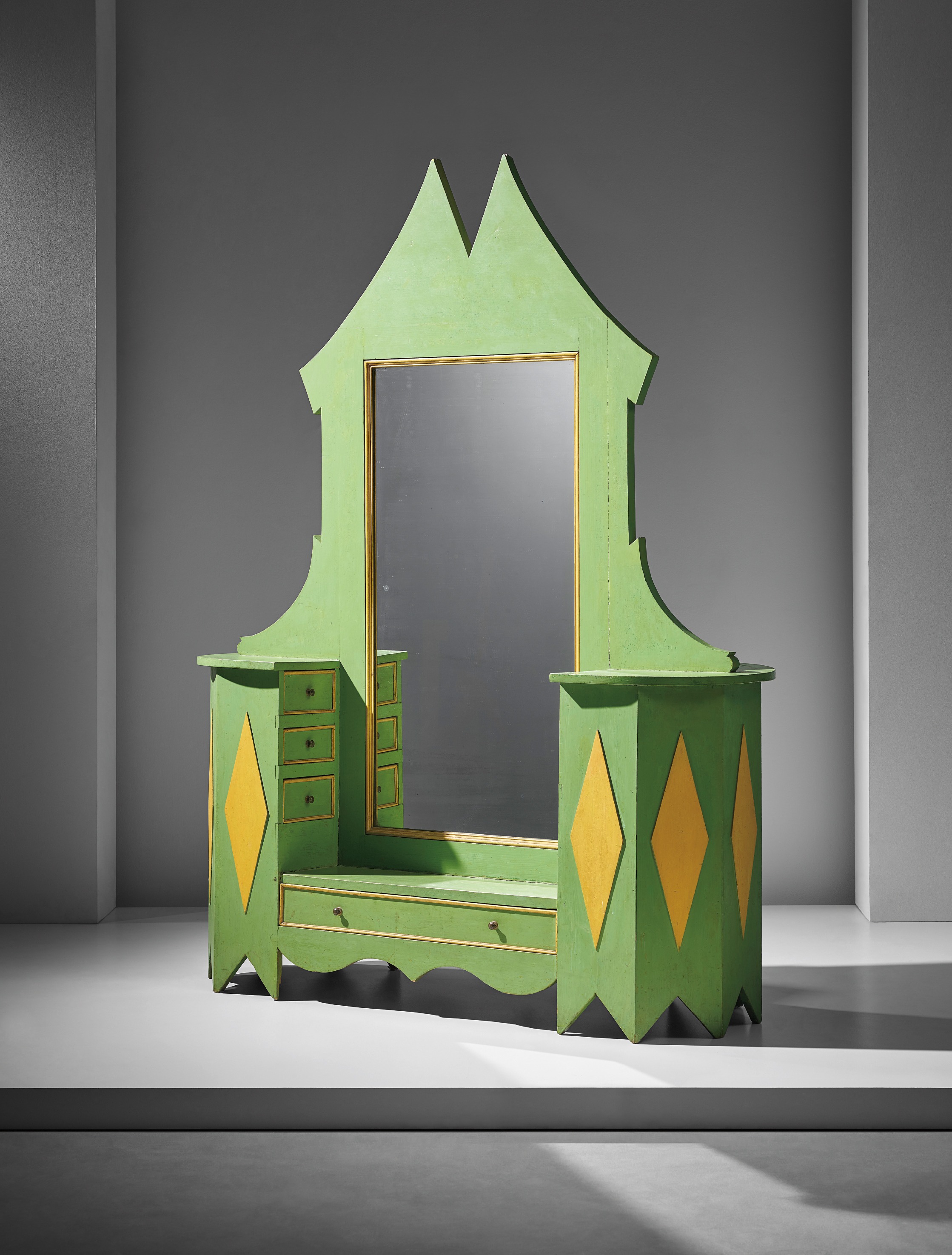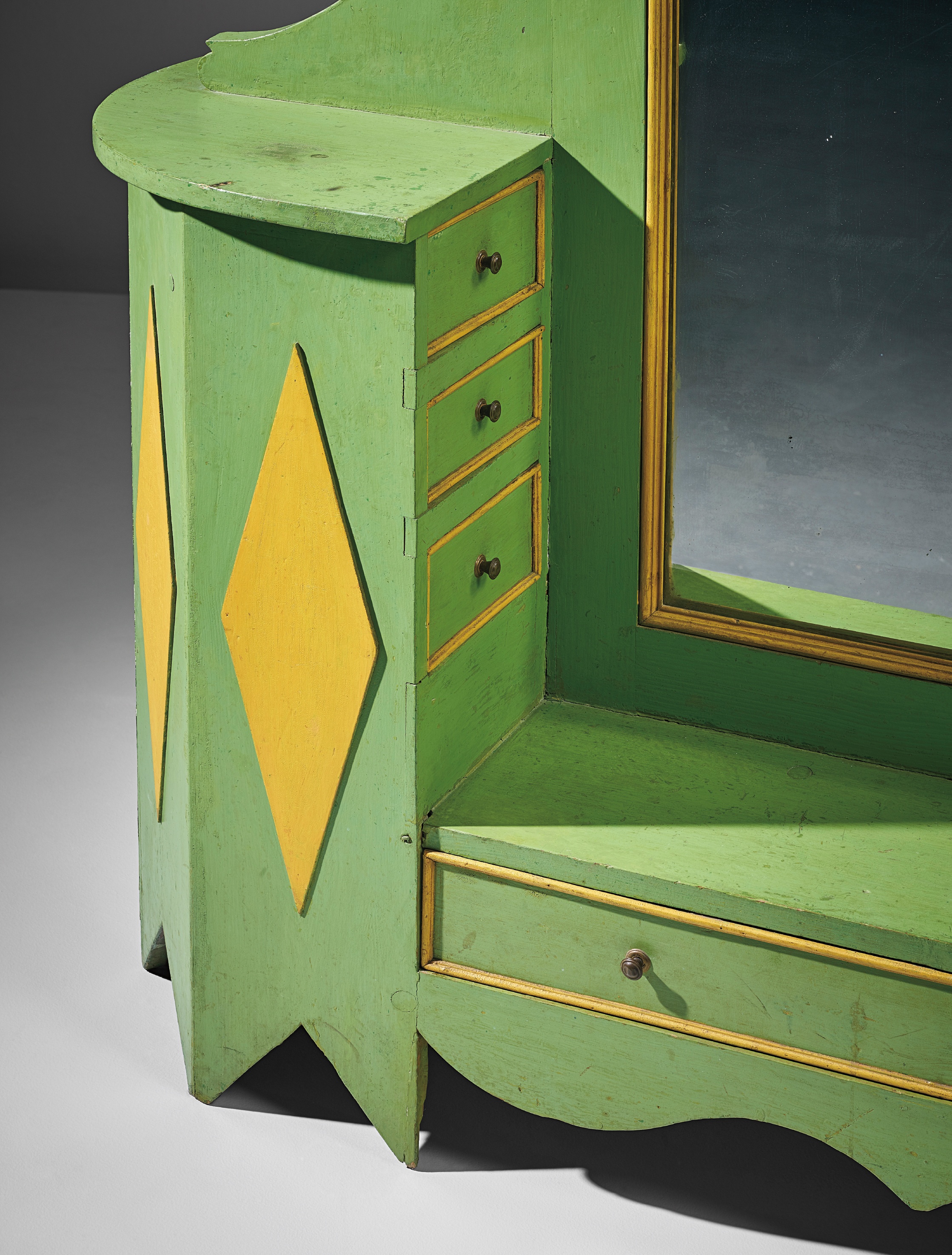



236
Giacomo Balla
Unique vanity
circa 1918
Painted oak, mirrored glass, brass.
158 x 151.5 x 55 cm (62 1/4 x 59 5/8 x 21 5/8 in.)
Together with a dossier by Maurizio Fagiolo dell'Arco and Elena Gigli.
Full-Cataloguing
Compenetrazioni iridescenti
In 1915, following the original ‘Futurist Painting: Technical Manifesto’ of 1910, Giacomo Balla and Fortunato Depero penned the pivotal manifesto ‘Futurist Reconstruction of the Universe’, through which they sought to regenerate Italian culture. Seeking a new outlook for every aspect of society, from clothing, textiles and furniture to architecture and games, the Futurist conception of the opera d’arte totale (total work of art) was created, transporting the observer into a wholly Futurist environment. In order to market their ideas and designs the artists opened case d’arte (art homes) and Balla transformed his Rome home to showcase his creations; having designed almost the complete contents of the residence, from the wardrobe handles and umbrella stands to quilts and furniture, the interior was a calculated Futurist creation.
Having pushed the formal dynamism of Futurist painting towards pure abstraction, Balla took his Futurist experiments back into practical, material dimensions. His first furniture designs stem from 1904, and his designs are united by his incorporation of what he called compenetrazioni iridescenti, the tiling of bold, simplistic shapes and colours. He brought the objects to life with diagonally orientated structures and illusions to create vortices of motion. The form and colour of the present lot reflect this practice. In drawing on his earliest sketches and experiments, Balla evoked speed and motion in his interior spaces whilst staying true to the functional value of the cabinet. Unlike other Futurists, Balla managed to incorporate the Futurist dynamism into his furniture and retain the practical use of the objects at the same time.
In an early design for the Lowenstein interior, in 1912, Balla mapped out a decorative scheme, projecting Futurist shards onto the walls, rugs and furniture surfaces. These early designs for actual spaces and objects relate to his experiments toward abstraction, combining his two and three-dimensional visualisations. Around 1915, he continued applying his abstract Futurist motifs to functional objects, such as his speed studies on his ‘Screen with Line of Speed and Vortex’ (circa 1915), distinguishing himself from his Futurist colleagues whose work at the time remained in the two-dimensional.
By 1918, the year of the present lot’s conception, Balla’s experiments with utilitarian objects took off, and he channelled his Futurist notions into designs for a vast range of utilitarian objects which included vases, lampshades, placemats, Futurist chairs, jointed furniture and the present cabinet. The majority of these designs were ultimately produced. In his 1918 visualisations of an interior his ambitions for the conception of space are evident. The design illustrated here specifies that Futurist paintings are to be spaced out between walls decorated with angular Futurist forms; another design from the same year places a lamp amidst the intersecting forms and lines. Balla desired to eliminate the boundaries between canvas, wall decoration and functional design. His legacy is both a metaphor for the ambitions of the Futurist movement and the precursor to growing modernist notions. With the present lot, Balla undertook to challenge ‘decorative art’ with representations of modern technology, uniting the visual with the functional.
In 1915, following the original ‘Futurist Painting: Technical Manifesto’ of 1910, Giacomo Balla and Fortunato Depero penned the pivotal manifesto ‘Futurist Reconstruction of the Universe’, through which they sought to regenerate Italian culture. Seeking a new outlook for every aspect of society, from clothing, textiles and furniture to architecture and games, the Futurist conception of the opera d’arte totale (total work of art) was created, transporting the observer into a wholly Futurist environment. In order to market their ideas and designs the artists opened case d’arte (art homes) and Balla transformed his Rome home to showcase his creations; having designed almost the complete contents of the residence, from the wardrobe handles and umbrella stands to quilts and furniture, the interior was a calculated Futurist creation.
Having pushed the formal dynamism of Futurist painting towards pure abstraction, Balla took his Futurist experiments back into practical, material dimensions. His first furniture designs stem from 1904, and his designs are united by his incorporation of what he called compenetrazioni iridescenti, the tiling of bold, simplistic shapes and colours. He brought the objects to life with diagonally orientated structures and illusions to create vortices of motion. The form and colour of the present lot reflect this practice. In drawing on his earliest sketches and experiments, Balla evoked speed and motion in his interior spaces whilst staying true to the functional value of the cabinet. Unlike other Futurists, Balla managed to incorporate the Futurist dynamism into his furniture and retain the practical use of the objects at the same time.
In an early design for the Lowenstein interior, in 1912, Balla mapped out a decorative scheme, projecting Futurist shards onto the walls, rugs and furniture surfaces. These early designs for actual spaces and objects relate to his experiments toward abstraction, combining his two and three-dimensional visualisations. Around 1915, he continued applying his abstract Futurist motifs to functional objects, such as his speed studies on his ‘Screen with Line of Speed and Vortex’ (circa 1915), distinguishing himself from his Futurist colleagues whose work at the time remained in the two-dimensional.
By 1918, the year of the present lot’s conception, Balla’s experiments with utilitarian objects took off, and he channelled his Futurist notions into designs for a vast range of utilitarian objects which included vases, lampshades, placemats, Futurist chairs, jointed furniture and the present cabinet. The majority of these designs were ultimately produced. In his 1918 visualisations of an interior his ambitions for the conception of space are evident. The design illustrated here specifies that Futurist paintings are to be spaced out between walls decorated with angular Futurist forms; another design from the same year places a lamp amidst the intersecting forms and lines. Balla desired to eliminate the boundaries between canvas, wall decoration and functional design. His legacy is both a metaphor for the ambitions of the Futurist movement and the precursor to growing modernist notions. With the present lot, Balla undertook to challenge ‘decorative art’ with representations of modern technology, uniting the visual with the functional.